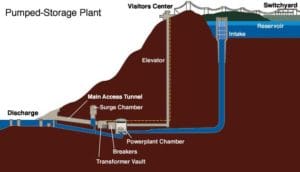PUMPED STORAGE
Pumped storage is an essential solution for grid reliability, providing one of the few large-scale, affordable means of storing and deploying electricity. Pumped storage projects store and generate energy by moving water between two reservoirs at different elevations. At times of low electricity demand, like at night or on weekends, excess energy is used to pump water to an upper reservoir. During periods of high electricity demand, the stored water is released through turbines in the same manner as a conventional hydro station, flowing downhill from the upper reservoir into the lower and generating electricity. The turbine is then able to also act as a pump, moving water back uphill.

Pumped storage is one of the most cost-effective utility-scale options for grid energy storage, acting as a key provider of what is known as ancillary services. Ancillary services include network frequency control and reserve generation – ways of balancing electricity across a large grid system. With an ability to respond almost instantaneously to changes in the amount of electricity running through the grid, pumped storage is an essential component of the nation’s electricity network.
The U.S. has more than 20GW of pumped storage capacity today, with facilities in every region of the country. Developers have proposed an additional 31GW, primarily in the West, to support an increasing amount of variable generation that is coming online.


